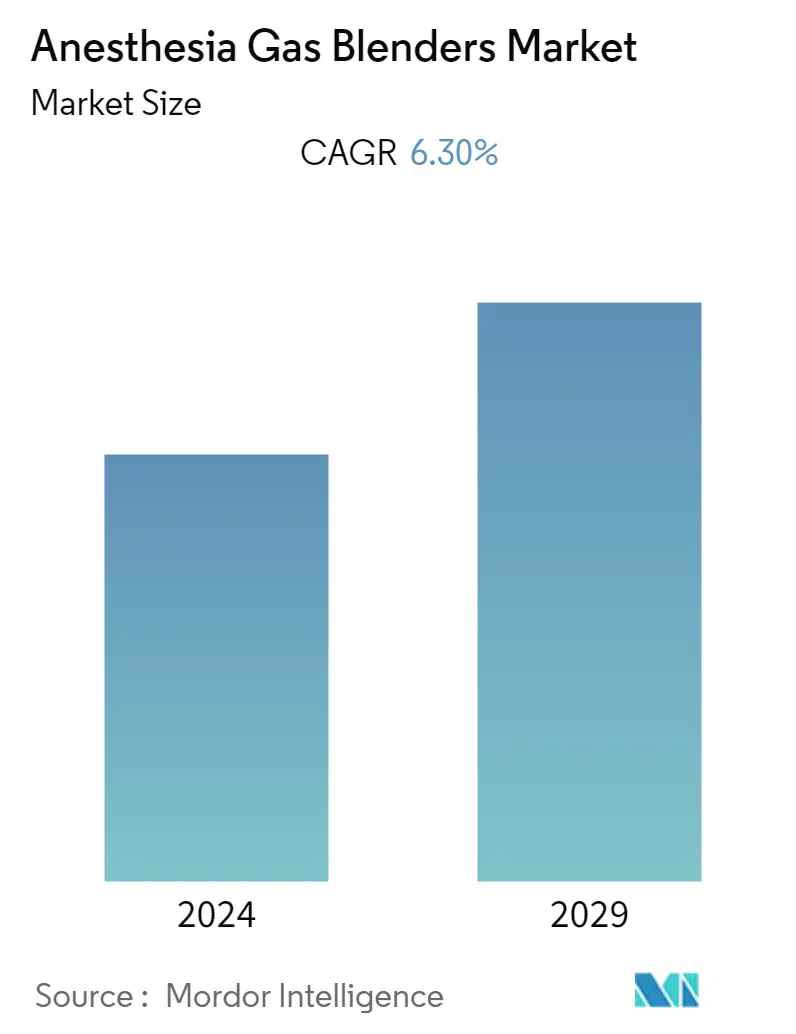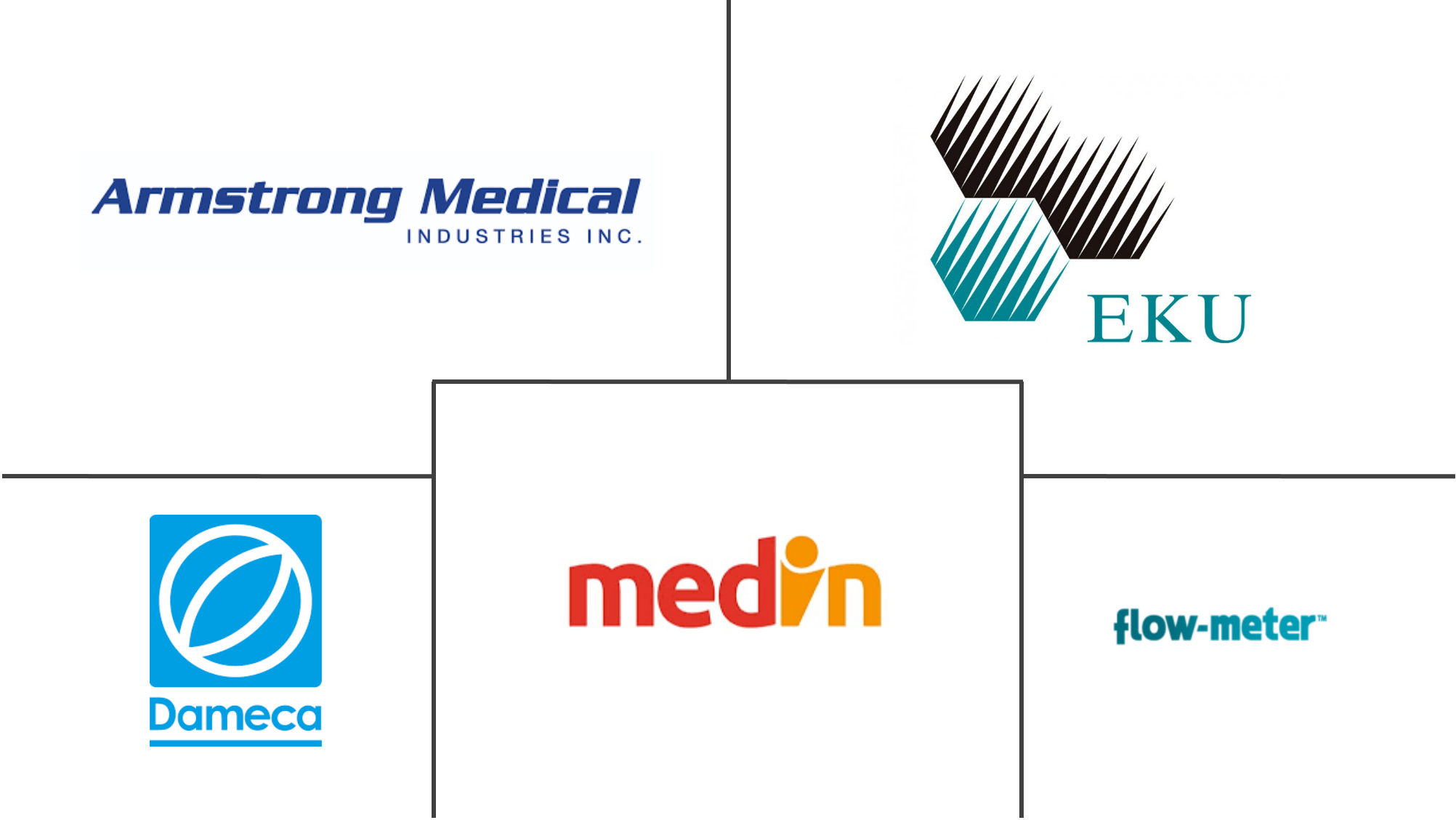Market Size of Anesthesia Gas Blenders Industry

| Study Period | 2019 - 2029 |
| Base Year For Estimation | 2023 |
| Forecast Data Period | 2024 - 2029 |
| Historical Data Period | 2019 - 2022 |
| CAGR | 6.30 % |
| Fastest Growing Market | Asia Pacific |
| Largest Market | North America |
Major Players
*Disclaimer: Major Players sorted in no particular order |
Anesthesia Gas Blenders Market Analysis
The anesthesia gas blenders market will show a rapid growth due to the increase in the number of outpatient surgeries, rising preference for inhaled anesthesia and increase in the number of well equiped multispeciality hospitals and surgical centers.
According to the OECD statistics, during 2017, it was estimated that around 4.8 million surgical admissions were recorded in the United Kingdom. In 2017, hernia operation, hip replacement, and knee replacement were the most common surgical procedures recorded, all of which involve the use of inhaled anaesthesia through devices.
As the surgeries are increasing the medical devices are extensively used in the surgical process. Therefore, in general, the need for anaesthesia gas blenders to administer the calculated and exact amount of anaesthesia to the person undergoing a certain surgical procedure has fueled the market growth of anaesthesia gas blenders market. Therefore an increase in the number of outpatient surgeries has helped in driving the demand for anaesthesia gas blender market.
Anesthesia Gas Blenders Industry Segmentation
As per the scope of the report, anesthesia gas blender is found to be a main component of anesthesia delivery machine. It is a medical device which mixes two or more gases and provides constant and controlled anesthesia during surgery. It contains gases for example, air/oxygen and are blended with nitrous oxide and other anesthesia gases in a specific amount to the patient experiencing in delayed surgery.
| By Technology | |
| Tube Flow Meter | |
| Dual Tube Flow Meter |
| By System Type | |
| Electronic | |
| Manual |
| By End User | |
| Hospitals | |
| Ambulatory Surgical Centers | |
| Others |
| Geography | ||||||||
| ||||||||
| ||||||||
| ||||||||
| ||||||||
|
Anesthesia Gas Blenders Market Size Summary
The anesthesia gas blenders market is poised for rapid expansion, driven by the increasing number of outpatient surgeries and a growing preference for inhaled anesthesia. This trend is further supported by the rise in well-equipped multispecialty hospitals and surgical centers. The demand for anesthesia gas blenders is fueled by the necessity to administer precise amounts of anesthesia during surgical procedures, which is becoming more prevalent with the rise in surgeries such as hernia operations, hip, and knee replacements. Hospitals are the primary contributors to the market's growth, attributed to the increasing prevalence of chronic conditions and the frequency of various surgeries, including orthopedic and gastrointestinal procedures. The preference for inhalable anesthesia, due to its low blood solubility and elimination through the lungs, is also contributing to the market's expansion, alongside the rising number of cosmetic procedures globally.
Regionally, North America holds the largest market share, driven by a focus on accurate and safe anesthesia delivery, increased healthcare expenditure, and a high prevalence of chronic diseases. Europe follows as the second leading market, with Asia Pacific expected to exhibit significant growth due to medical tourism, a rising number of surgeries, and technological advancements. The market is characterized by the presence of numerous companies engaged in product innovation and research and development to advance technologies. Key players are employing various strategies and collaborations to sustain their market position, with companies like Medin Medical Innovations GmbH, Flow-Meter S.p.A., and Armstrong Medical Inc. playing significant roles in the market's development.
Anesthesia Gas Blenders Market Size - Table of Contents
-
1. MARKET DYNAMICS
-
1.1 Market Overview
-
1.2 Market Drivers
-
1.2.1 Increase in the Number of Outpatient Surgeries
-
1.2.2 Rising Preference for Inhaled Anesthesia
-
1.2.3 Increase in the Number of Well Equipped Multi-speciality Hospitals and Surgical Centers
-
-
1.3 Market Restraints
-
1.3.1 Adoption of Electronic Blenders over Manual
-
-
1.4 Porter's Five Force Analysis
-
1.4.1 Threat of New Entrants
-
1.4.2 Bargaining Power of Buyers/Consumers
-
1.4.3 Bargaining Power of Suppliers
-
1.4.4 Threat of Substitute Products
-
1.4.5 Intensity of Competitive Rivalry
-
-
-
2. MARKET SEGMENTATION
-
2.1 By Technology
-
2.1.1 Tube Flow Meter
-
2.1.2 Dual Tube Flow Meter
-
-
2.2 By System Type
-
2.2.1 Electronic
-
2.2.2 Manual
-
-
2.3 By End User
-
2.3.1 Hospitals
-
2.3.2 Ambulatory Surgical Centers
-
2.3.3 Others
-
-
2.4 Geography
-
2.4.1 North America
-
2.4.1.1 United States
-
2.4.1.2 Canada
-
2.4.1.3 Mexico
-
-
2.4.2 Europe
-
2.4.2.1 Germany
-
2.4.2.2 United Kingdom
-
2.4.2.3 France
-
2.4.2.4 Italy
-
2.4.2.5 Spain
-
2.4.2.6 Rest of Europe
-
-
2.4.3 Asia-Pacific
-
2.4.3.1 China
-
2.4.3.2 Japan
-
2.4.3.3 India
-
2.4.3.4 Australia
-
2.4.3.5 South Korea
-
2.4.3.6 Rest of Asia-Pacific
-
-
2.4.4 Middle-East and Africa
-
2.4.4.1 GCC
-
2.4.4.2 South Africa
-
2.4.4.3 Rest of Middle-East and Africa
-
-
2.4.5 South America
-
2.4.5.1 Brazil
-
2.4.5.2 Argentina
-
2.4.5.3 Rest of South America
-
-
-
Anesthesia Gas Blenders Market Size FAQs
What is the current Anesthesia Gas Blenders Market size?
The Anesthesia Gas Blenders Market is projected to register a CAGR of 6.3% during the forecast period (2025-2030)
Who are the key players in Anesthesia Gas Blenders Market?
Medin Medical Innovations GmbH, Flow-Meter S.p.A., Dameca A/S, EKU Electronics and Armstrong Medical Inc. are the major companies operating in the Anesthesia Gas Blenders Market.

